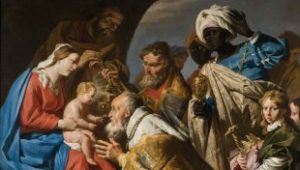Valerie Tarico in AlterNet:
 Picture a creche with baby Jesus in a manger and shepherds and angels and three kings and a star over the stable roof. We think of this traditional scene as representing the Christmas story, but it actually mixes elements from two different nativity stories in the Bible, one in Matthew and one in Luke, with a few embellishments that got added in later centuries. What was the historical kernel? Most likely we will never know, because it appears that the Bible’s nativity stories are themselves highly-embellished late add-ons to the Gospels.
Picture a creche with baby Jesus in a manger and shepherds and angels and three kings and a star over the stable roof. We think of this traditional scene as representing the Christmas story, but it actually mixes elements from two different nativity stories in the Bible, one in Matthew and one in Luke, with a few embellishments that got added in later centuries. What was the historical kernel? Most likely we will never know, because it appears that the Bible’s nativity stories are themselves highly-embellished late add-ons to the Gospels.
Here are six hints that the story so familiar to us might have been unfamiliar to early Jesus worshipers.
1. Paul’s Silence –The earliest texts in the New Testament are letters written during the first half of the first century by Paul and other people who used his name. These letters, or Epistles as they are called, give no hint that Paul or the forgers who used his name had heard about any signs and wonders surrounding the birth of Jesus, nor that his mother was a virgin impregnated by God in spirit form. Paul simply says that he was a Jew, born to a woman.
2. Mark’s Silence –The Gospel of Mark—thought to be the earliest of the four gospels and, so, closest to actual events—doesn’t contain a nativity or “infancy” story, even though it otherwise looks to be the primary source document for Matthew and Luke. In Mark, the divinity of Jesus gets established by wonders at the beginning of his ministry, and some Christian sects have believed that he was adopted by God at this point. Why is Mark thought to be where the authors of Matthew and Luke got material? For starters, some passages in Mark, Matthew, and Luke would likely get flagged by plagiarism software. But in the original Greek, Mark is the most primitive and least polished of the three. It also is missing powerful passages like the Sermon on the Mount and has endings that vary from copy to copy. These are some of the reasons that scholars believe it predates the other two. Unlike Paul, the author of Mark was writing a life history of Jesus, one that was full of miracles. It would have been odd for him to simply leave out the auspicious miracles surrounding the birth of Jesus—unless those stories didn’t yet exist.
More here.
